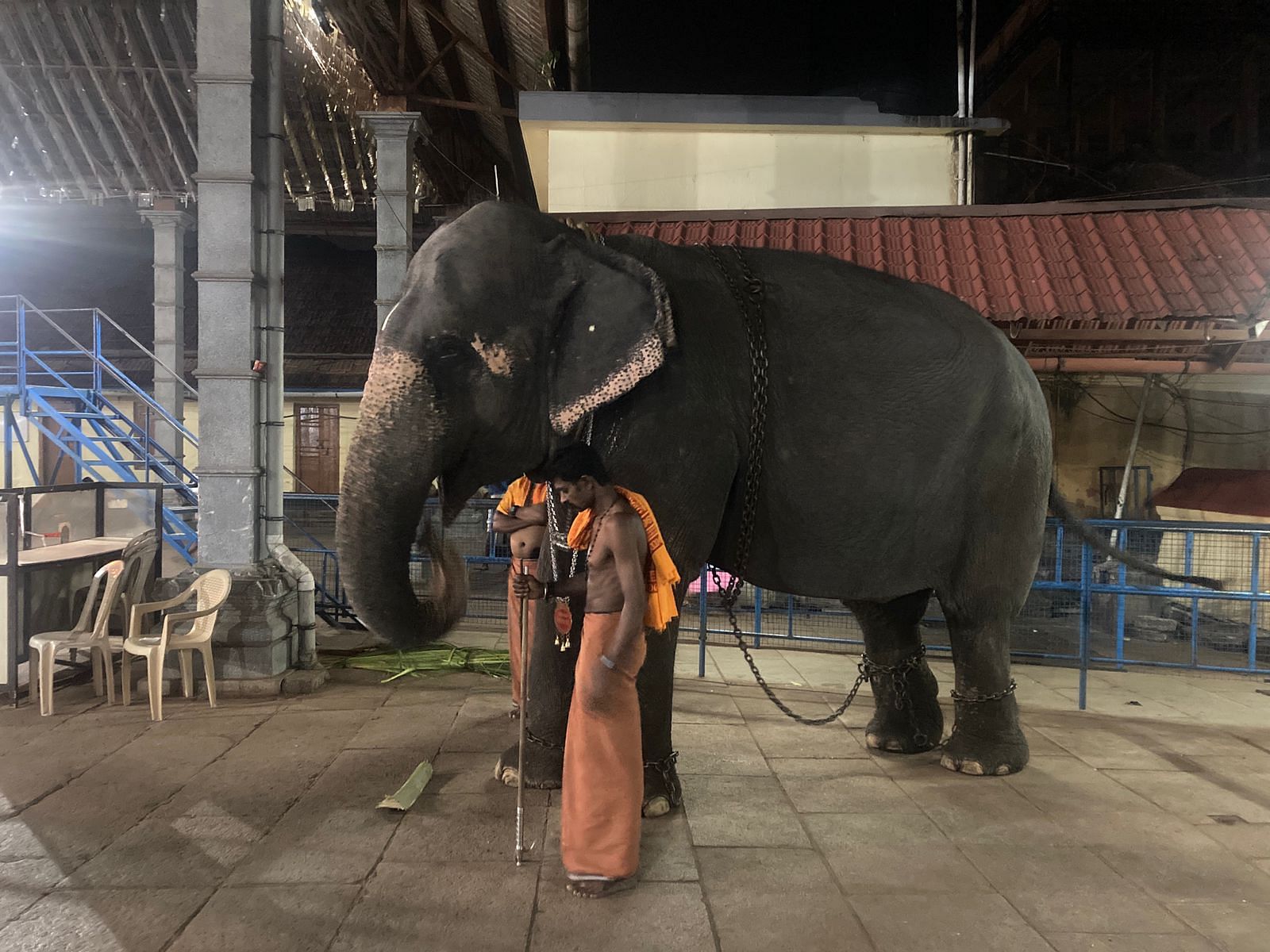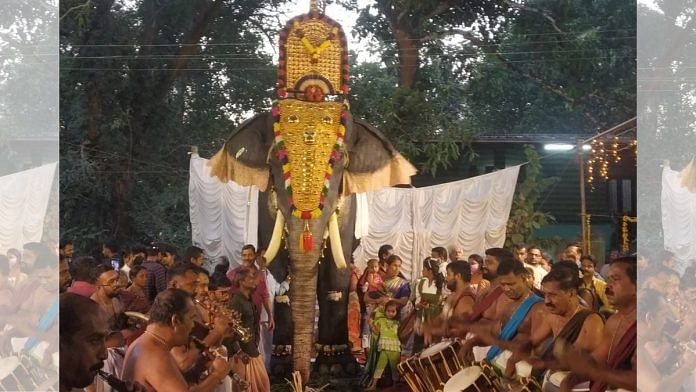Kochi: It wasn’t God drawing people to the Irinjadappilly Sree Krishna Temple in Kerala’s Thrissur that Sunday — it was Irinjadappilly Raman, their new mechanical elephant.
The temple is the first to introduce a robot elephant to conduct its rituals in an attempt to be cruelty-free, a transformative cultural shift to the temple culture in a state that calls itself the God’s own country. The astonishingly life-like elephant was given as a gift to the temple by People for Ethical Treatment of Animals (PETA), with the support of actor Parvathy Thiruvothu.
“There were huge crowds to see Raman! Queues and queues of people, especially women and children,” said Rajkumar, the devaswom officer at the temple. The Nadayiruthal ceremony — in which the elephant was presented to the Gods — was conducted on 26 February 2023.
Raman is 10-and-a-half feet tall, weighs 800 kg, and has skin made from rubber. His eyes, mouth, ears and tail are all mechanised. He costs around Rs 5 lakh, and can carry four people. But the robot’s ability to carry traditional temple-going people’s hearts and minds along is up for debate in Kerala.
The state’s temples regularly use elephants for rituals—from blessing devotees to pulling chariots of deities in processions. Kerala is home to about one fifth of India’s roughly 2,500 captive elephants. Just last week, the Centre for Research on Animal Rights (CRAR) wrote to Chief Minister Pinarayi Vijayan requesting a probe into the deaths of captive elephants, saying that 138 elephants died in Kerala between 2018 and 2023.
“I was contacted by PETA asking whether I would associate with them on this project. It was a no-brainer, really,” wrote Parvathy to ThePrint. “I am more than delighted to support PETA India in helping Sree Krishna Temple worshippers experience the joy and sanctity of religious functions in an ‘ahimsak’, modern and conscientious manner.”
Also read: Modi govt push for temple corridors isn’t just about culture. It’s the economy
Revolutionary Raman
The decision to use robot Raman has caused both unease and curiosity across state temples in Kerala. Most temples are waiting to see how the experiment pans out.
Rajkumar hopes it’ll inspire other temples to begin phasing out alive elephants. He says it doesn’t look like Raman will have any technical issues but if he does, there are plenty of electricians on hand to help him out.
At Kochi’s Sree Poornathrayeesa Temple, devaswom officer Sudheer wonders aloud if a Raman-like robot elephant can reduce his temple’s expenditure.
“It costs a lot to care for elephants and also rent them for festivals — it gets very competitive during festivals like Shivratri and during the Pooram,” said Sudheer. “It’s minimum Rs. 20,000 a day, but can go over 3.5 lakh to rent an elephant.”
Poornathrayeesa Temple’s resident elephant, Govindan, does two daily rounds of the temple: at 6:30 am and 7:30 pm. Sudheer explains that if he has any issues — like if he’s unwell or if he’s moody — the temple has to rent another elephant for the day.
He’s not sure if Poornathrayeesa would ever invest in a robot elephant. “We’ll need the tantri’s permission,” he shrugs. Tantri is the final authority figure on matters relating to temple issues.
Deepesh, the devaswom officer at Kochi’s Chottanikkara Temple, is more certain: he will never consider getting a mechanical elephant. “Elephants are not only just decoration, they also bring a certain power to rituals. It’s like when a prime minister travels with a convoy of cars,” he said.
“It’s a blessing for the elephant to be able to symbolise the passage of God,” said Deepesh. “It’s not cruelty.”
God’s chariot
PETA hopes that Raman’s introduction will gain the attention of temples across India and is willing to offer to help them transition to mechanical elephants and away from real ones.
“The best form of worship of elephants, representatives of Lord Ganesha, is to allow them to live free as God intended, with their families, in nature,” said Khushboo Gupta, director of Advocacy Projects at PETA. She added that these elephants should be retired to sanctuaries, where they can live unchained, in the company of other elephants.
“PETA India is talking to several other Kerala temples in and outside Thrissur district about possibly supporting them with a switch to a mechanical elephant, palanquin or a chariot instead of using real elephants,” she added.
There have been several instances of cruelty towards elephants during festivals, according to CRAR. The founder of the organisation, Alok Gupta, said that problems during captivity have led to the death of over 100 elephants in the last five years. Sharp objects are often used to control elephants to force them to participate in rituals. And between 2014 and 2021, there have been at least 50 instances of elephants killing their mahouts out of stress.
But the question of artificiality still looms large over devaswom officers like Deepesh, who says that he personally could not accept a mechanical elephant in place of a real one. His temple’s resident elephant, Minimol, stands chained near the upper temple, munching on grass.

“I would redirect the question back to them, asking if artificiality is more bothersome than innocent lives being tortured,” wrote Parvathy to ThePrint. “When it comes to faith, I’m sure there is always a way to exercise it that doesn’t harm other living things.”
Also read: Politics has no role in daily worship and festivals of temples, says Kerala HC
Kerala’s elephant mania
There’s an “aanakampam” in Kerala: an elephant mania.
In Kerala, human characteristics are ascribed to elephants: people celebrate their birthdays and funerals, read poetry about their grace and might, and novels about elephants and their mahouts. One of the most famous elephants, Guruvayur Kesavan, even had a film made about him in 1977.
There’s little historical documentation for how elephants came to be such an important part of temple culture in the state. In fact, they used to be actively procured for temples and timber. While Kerala has a significant population of wild elephants, sometimes they would also be imported from other Indian states.
Apart from being considered auspicious in temples, they are also used by politicians in rallies and have become a tourist attraction of sorts. Most temple festivals in Kerala make use of elephants, the most famous being the Thrissur Pooram and Arattupuzha Pooram.
“Elephants are now part of temple rituals in Kerala. But it’s not written in any religious text that they are necessary. It’s only referenced as chariots to God, just like Garuda vahana etc,” said Rajkumar.
Dismissing any further criticisms against Raman and the potential use of other mechanical elephants, Rajkumar said that knowledgeable scholars of Hinduism and temple culture inaugurated the function such as NR Satheeshan Namboothiri, Chief Priest of the famous Padmanabhaswamy Temple in Thiruvananthapuram, and scholar T. Vijayan Thanthrikal.
“Who would know better than such learned scholars about temple culture?” said Rajkumar. “Elephants are only like an item of decoration. They are not necessary or integral to ritual practice.”
(Edited by Ratan Priya)



